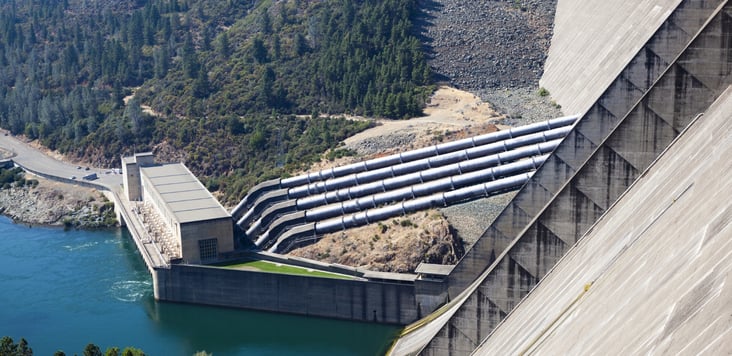This post is one in a series featuring the complete slate of advanced energy technologies outlined in the report This Is Advanced Energy.

Hydroelectric power plants use turbines and generators to convert the kinetic energy of moving water into electricity. There are three major types of hydroelectric power plants: impoundment, run-of-river (diversion), and pumped storage. An impoundment facility uses a dam to store river water in a reservoir, which it then releases through turbines to generate electricity. The height differential (“hydraulic head”) between the reservoir surface and the turbine outlet is what provides the energy for power generation. A run-of-river facility takes advantage of natural elevation changes along a river, diverting a portion of the river flow via pipes or underground conduits to drive turbines and generate power without a dam. Because of this design, the output from run-of-river plants can uctuate throughout the year, whereas impoundment plants generally have steadier output. Pumped hydro storage is a form of bulk energy storage that generates electricity when demand is high. In addition to these three major variants, there is a niche application called in-conduit hydropower, which uses hydro turbines to harness energy from water supply infrastructure such as tunnels, irrigation canals, and pipes.
Hydroelectric power currently constitutes the largest and oldest source of renewable electricity in the United States, producing 51% of renewable electricity and 7% of total electricity from all sources in 2013, not including pumped hydro. This energy comes from over 2,500 hydroelectric facilities in the United States with a total capacity of approximately 78 GW. Although the country’s major hydroelectric resource is largely developed, there was a net capacity increase of nearly 1.5 GW from 2005 to 2013, and there is the potential to increase capacity by about 12 GW by adding generation at existing dams that do not currently generate electricity. The Pacific Northwest, California, and the Southeast are particularly rich in hydroelectric power. Southern Company, the largest electricity producer in the country, operates 34 hydroelectric facilities in Alabama and Georgia alone, which generate enough power to meet the needs of over 200,000 customers.
The U.S. hydroelectric power industry currently employs approximately 300,000 workers through project development, manufacturing, and facility operations and maintenance. An estimated $4 billion has been invested over the past four years to repower or upgrade existing plants, develop small projects, and add pumped storage. Hydroelectric power also offers many reliability benefits, providing both baseload power and exible generation that can respond very rapidly to changes in demand. In addition, hydroelectric plants can provide what is known as a “black start capability,” or the ability to resume operation in isolation from the rest of the grid to enable the entire system to come back online, as happened during a blackout in 2003 that affected 50 million people from New York to Michigan.
